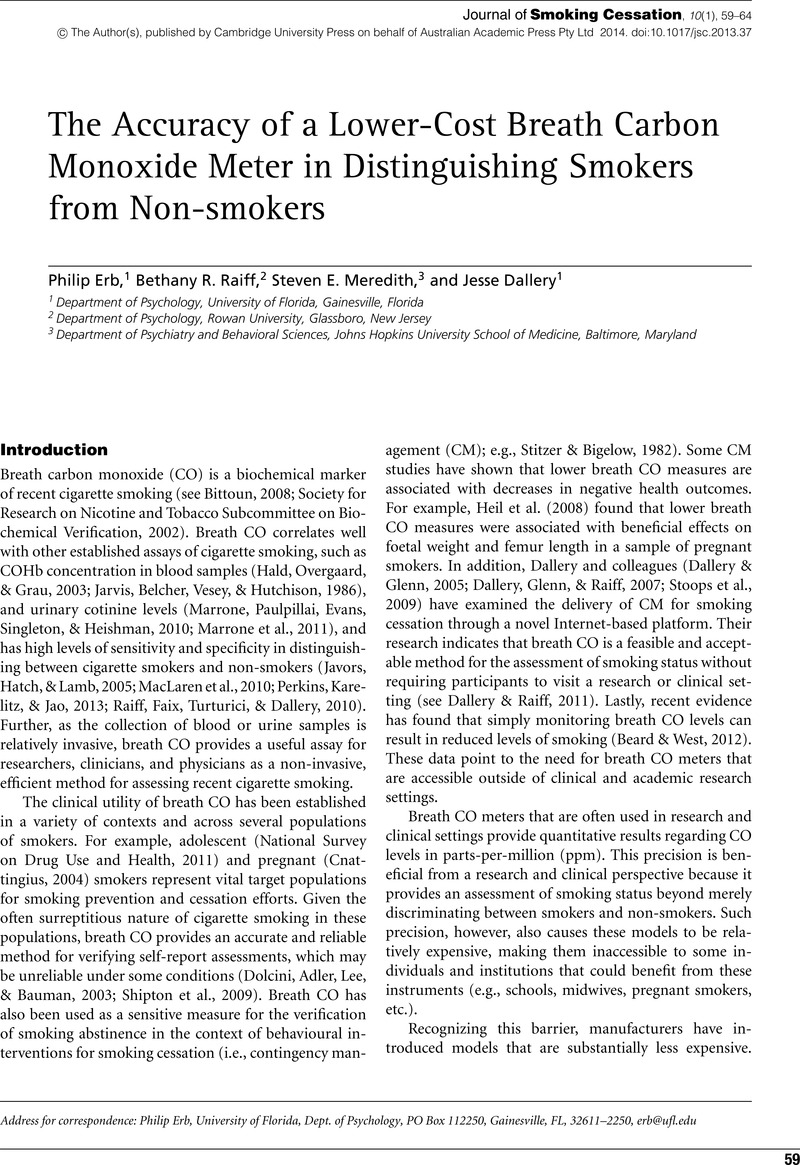Crossref Citations
This article has been cited by the following publications. This list is generated based on data provided by Crossref.
Karelitz, Joshua L.
Michael, Valerie C.
Boldry, Margaret
and
Perkins, Kenneth A.
2016.
Validating Use of Internet-Submitted Carbon Monoxide Values by Video to Determine Quit Status.
Nicotine & Tobacco Research,
p.
ntw311.
Karelitz, Joshua L.
Michael, Valerie C.
and
Perkins, Kenneth A.
2017.
Analysis of Agreement between Expired-Air Carbon Monoxide Monitors.
Journal of Smoking Cessation,
Vol. 12,
Issue. 2,
p.
105.
Fakir, Adnan M. S.
Aziz, Mustahsin
Mubde, Mutasim Billah
Karim, Afraim
Khan, Ashraf S.
Raisa, Rifayat
Alim, Lubaba Ferdous
and
Fahmin, Mayeesha
2018.
Bangladesh Chars Tobacco Assessment Project (CTAP) 2018: a data note.
BMC Research Notes,
Vol. 11,
Issue. 1,
Reynolds, Ciara Marie Edel
Egan, Brendan
Kennedy, Rachel AK
O’Malley, Eimer G
Sheehan, Sharon R
and
Turner, Michael J
2018.
A prospective, observational study investigating the use of carbon monoxide screening to identify maternal smoking in a large university hospital in Ireland.
BMJ Open,
Vol. 8,
Issue. 7,
p.
e022089.
Yoshida, N
Baba, Y
Kuroda, D
Miyamoto, Y
Iwatsuki, M
Hiyoshi, Y
Ishimoto, T
Sawayama, H
Imamura, Y
Watanabe, M
and
Baba, H
2018.
Clinical utility of exhaled carbon monoxide in assessing preoperative smoking status and risks of postoperative morbidity after esophagectomy.
Diseases of the Esophagus,
Vol. 31,
Issue. 9,
Reynolds, Ciara M.E.
Egan, Brendan
Kennedy, Rachel A.
O’Malley, Eimer
Sheehan, Sharon R.
and
Turner, Michael J.
2019.
The implications of high carbon monoxide levels in early pregnancy for neonatal outcomes.
European Journal of Obstetrics & Gynecology and Reproductive Biology,
Vol. 233,
Issue. ,
p.
6.
Wong, Hsui Yang
Subramaniyan, Muniswary
Bullen, Chris
A. N., Amer Siddiq
Danaee, Mahmoud
and
Yee, Anne
2019.
The mobile-phone-based iCO<sup>TM</sup> Smokerlyzer<sup>®</sup>: Comparison with the piCO<sup>+</sup> Smokerlyzer<sup>®</sup> among smokers undergoing methadone-maintained therapy.
Tobacco Induced Diseases,
Vol. 17,
Issue. September,
Tuck, Breanna M
Karelitz, Joshua L
Tomko, Rachel L
Dahne, Jennifer
Cato, Patrick
and
McClure, Erin A
2021.
Mobile, Remote, and Individual Focused: Comparing Breath Carbon Monoxide Readings and Abstinence Between Smartphone-Enabled and Stand-Alone Monitors.
Nicotine & Tobacco Research,
Vol. 23,
Issue. 4,
p.
741.
Maia-Silva, Keyla Medeiros
Zamel, Noe
Selby, Peter
Fontes, Cor Jesus Fernandes
and
Santos, Ubiratan Paula
2021.
Tobacco smoking associated with adverse childhood experiences in a Brazilian community university sample: A case-control study.
Children and Youth Services Review,
Vol. 120,
Issue. ,
p.
105438.
Schwaninger, Philipp
Berli, Corina
Scholz, Urte
and
Lüscher, Janina
2021.
Effectiveness of a Dyadic Buddy App for Smoking Cessation: Randomized Controlled Trial.
Journal of Medical Internet Research,
Vol. 23,
Issue. 9,
p.
e27162.
Keskin, Gamze
Tunç Karaman, Sibel
and
Basat, Okcan
2021.
Evaluation of the relationship between the level of addiction
and exhaled carbon monoxide levels with QT dispersion in
smokers.
Tobacco Induced Diseases,
Vol. 19,
Issue. April,
p.
1.
Güden, Melih
Tunç Karaman, Sibel
and
Basat, Okcan
2022.
Evaluation of the relationship between the level of addiction
and exhaled carbon monoxide levels with neutrophil-to-lymphocyte
and platelet-to-lymphocyte ratios in smokers.
Tobacco Induced Diseases,
Vol. 20,
Issue. June,
p.
1.
TUNÇ KARAMAN, Sibel
and
BASAT, Okcan
2022.
EVALUATION OF SERUM SCUBE-1 LEVELS AND AFFECTING FACTORS IN SMOKERS.
Ahi Evran Medical Journal,
Mukadam, Ajinkya
Hegde-Shetiya, Sahana
and
Kale, Sonal
2023.
Validity of Self-Reported Smoking Cessation with Carbon Monoxide Cut-Off Point – A Systematic Review and Meta-Analysis of Diagnostic test Accuracy Studies.
Journal of Indian Academy of Oral Medicine and Radiology,
Vol. 35,
Issue. 4,
p.
605.



